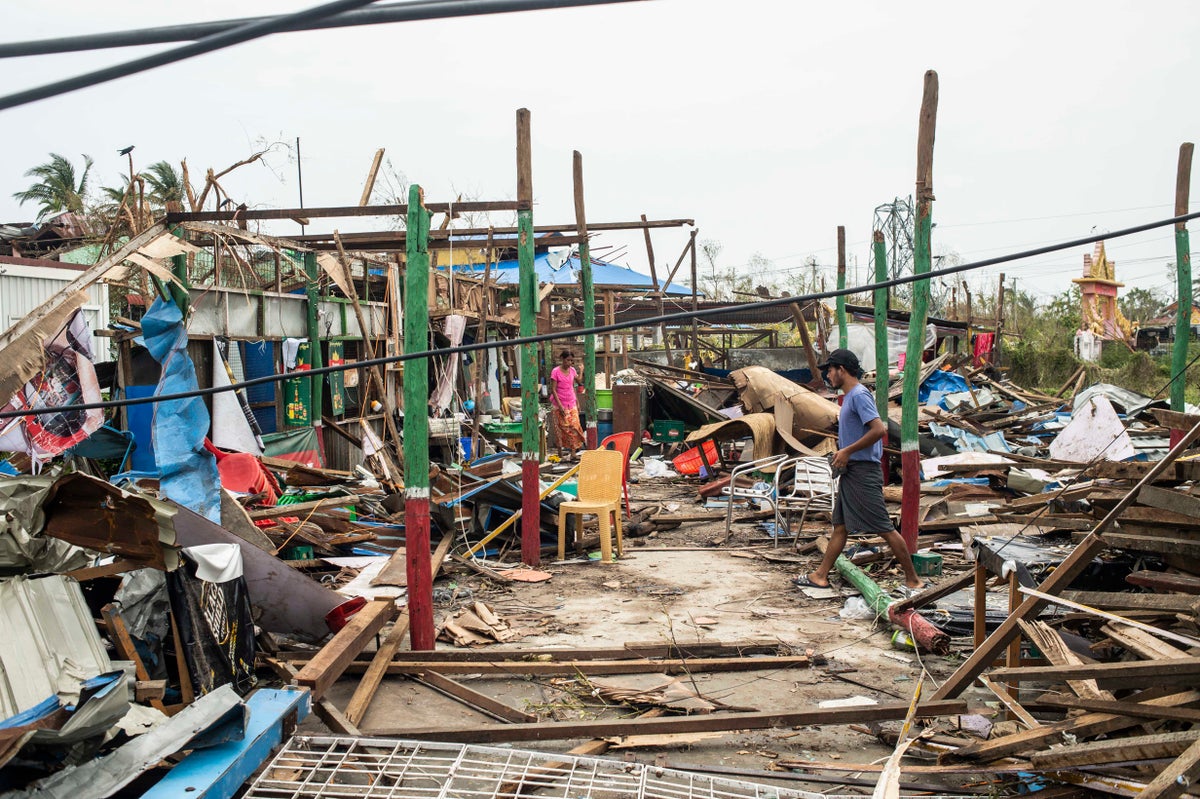
Recovery efforts were underway Tuesday in Myanmar and Bangladesh after a powerful cyclone smashed into their coastlines, causing widespread destruction and at least 21 deaths, with hundreds of others believed missing.
Myanmar took the brunt of Cyclone Mocha on Sunday, while Bangladesh was spared a feared catastrophe.
Residents of Myanmar’s Rakhine state worked to repair the damage and mourn the dead. Areas further inland also suffered damage, including the central city of Bagan, a UNESCO World Heritage Site that was Myanmar's capital 10 centuries ago.
Mocha made landfall near Sittwe township in Rakhine state with winds of up to 209 kilometers (130 miles) per hour on Sunday afternoon, weakening to a tropical depression by midday Monday. The storm, the nation’s most destructive in a decade, brought widespread flash floods and power outages, while high winds tore roofs off buildings and crumpled cellphone towers.
Myanmar state-run television MRTV said Tuesday that 21 people were killed and 11,532 houses, 73 religious buildings, 47 monasteries, 163 schools, 29 hospitals and clinics and 112 government buildings were damaged.
Independent media said hundreds more people were believed missing. Many of those reported dead or unaccounted for had been living in ramshackle displacement camps that were reportedly heavily damaged by the storm surge.
The camps house members of the Muslim Rohingya minority who lost their homes in a brutal 2017 counterinsurgency campaign led by Myanmar security forces. Aid agency presence is spotty and help from the country's military government negligible.
It is difficult to confirm the extent of casualties and damage because telecommunication facilities in the area were damaged by the storm’s high winds. Information is hard to obtain even in normal times because the military restricts the media.
Sahat Khasin, a Rohingya who does relief work at one of the camps, said by phone he helped bury 11 bodies at a Muslim cemetery near Sittwe, Rakhine’s state capital on the Bay of Bengal.
He said the authorities warned people in the camps to evacuate to safer places in advance of the cyclone’s arrival, but some waited until seawater began pouring in.
Video from Sittwe on Tuesday showed extensive damage to buildings as well as uprooted trees and fallen power lines.
Heavy rain in Bagan, the ancient city that is one of Myanmar's major tourist attractions, caused flooding that weakened the foundations of at least four temples. MRTV reported that the head of Myanmar's military government, Senior Gen. Min Aung Hlaing, visited Tuesday to inspect the damage,
The government issued disaster declarations for 17 townships in Rakhine and four in Chin state, north of Rahkine, where hundreds of buildings were reported damaged.
Rohingya are not recognized as an official minority in Buddhist-majority Myanmar, where they face widespread discrimination and are denied citizenship and other basic rights. People living in the camps cannot move freely, according to human rights groups.
More than 700,000 other Rohingya fled the 2017 violence to live in refugee camps in neighboring Bangladesh, which also suffered damage from the cyclone but reported no deaths.
At the world’s largest refugee camp in Bangladesh’s Cox’s Bazar district, thousands of Rohingya from Myanmar were moved to safer areas until Cyclone Mocha passed. The low-lying area is especially vulnerable to flooding, with relatively few secure shelters available.
Bangladesh Prime Minister Sheikh Hasina said more than 700,000 people were moved to cyclone shelters or makeshift facilities including schools and mosques
“While the storm didn’t directly hit refugee settlements, as feared, it caused major damage,” Alexia Riviere, emergency coordinator in Bangladesh for Catholic Relief Services, a major aid agency, said in a statement. “The needs will likely be great as we assess the destruction. Our concerns in the wake of the storm include landslides and flash flooding."
Riviere described Cyclone Mocha as one of the largest storms to strike Bangladesh in decades, noting that Cyclone Sidr in 2007 killed more than 3,000 people and caused billions of dollars in damage.
“As an aid community, we have to face the fact that marginalized communities are becoming more vulnerable each year,” Riviere said. “The more we can do to prepare for the inevitable, the better.”




!["[T]he First and Fifth Amendments Require ICE to Provide Information About the Whereabouts of a Detained Person"](https://images.inkl.com/s3/publisher/cover/212/reason-cover.png?w=600)


